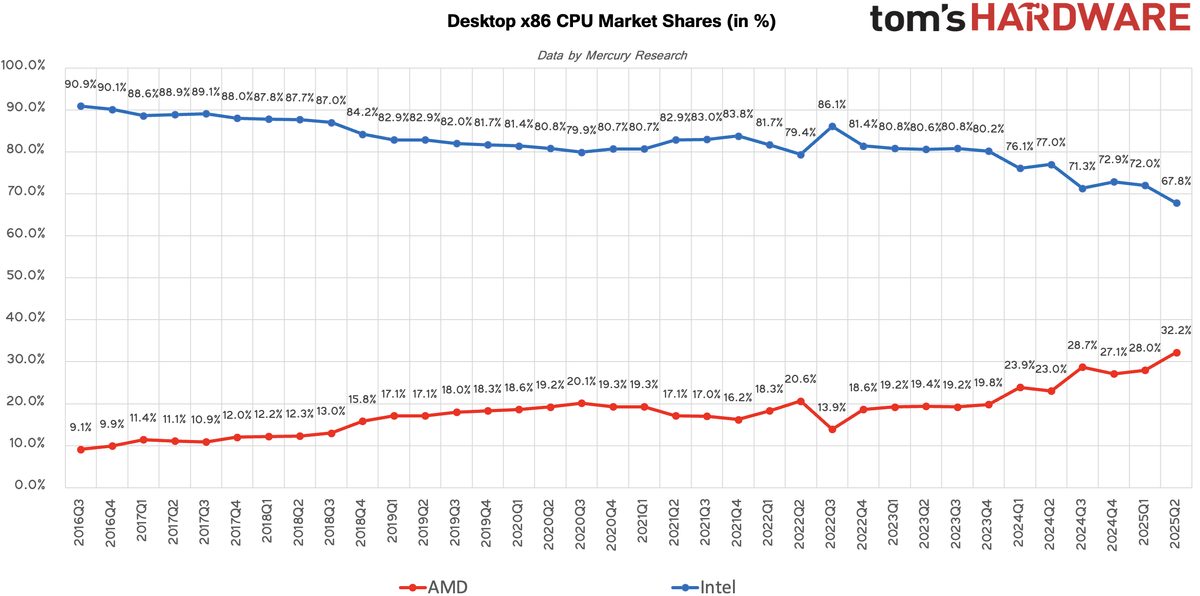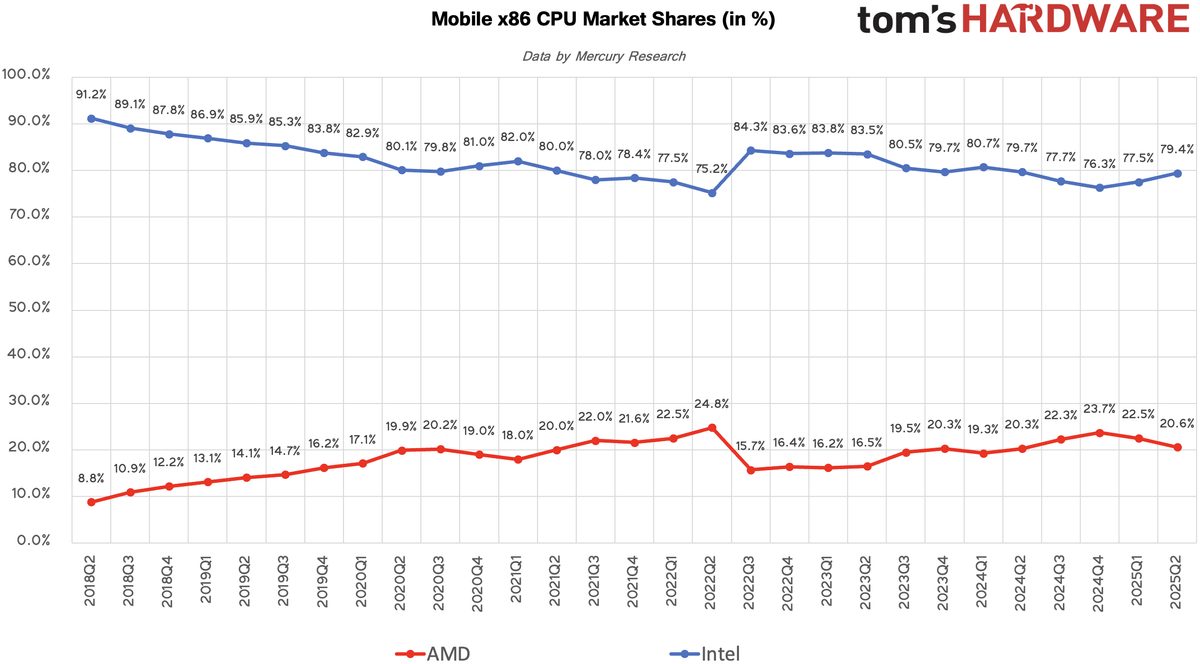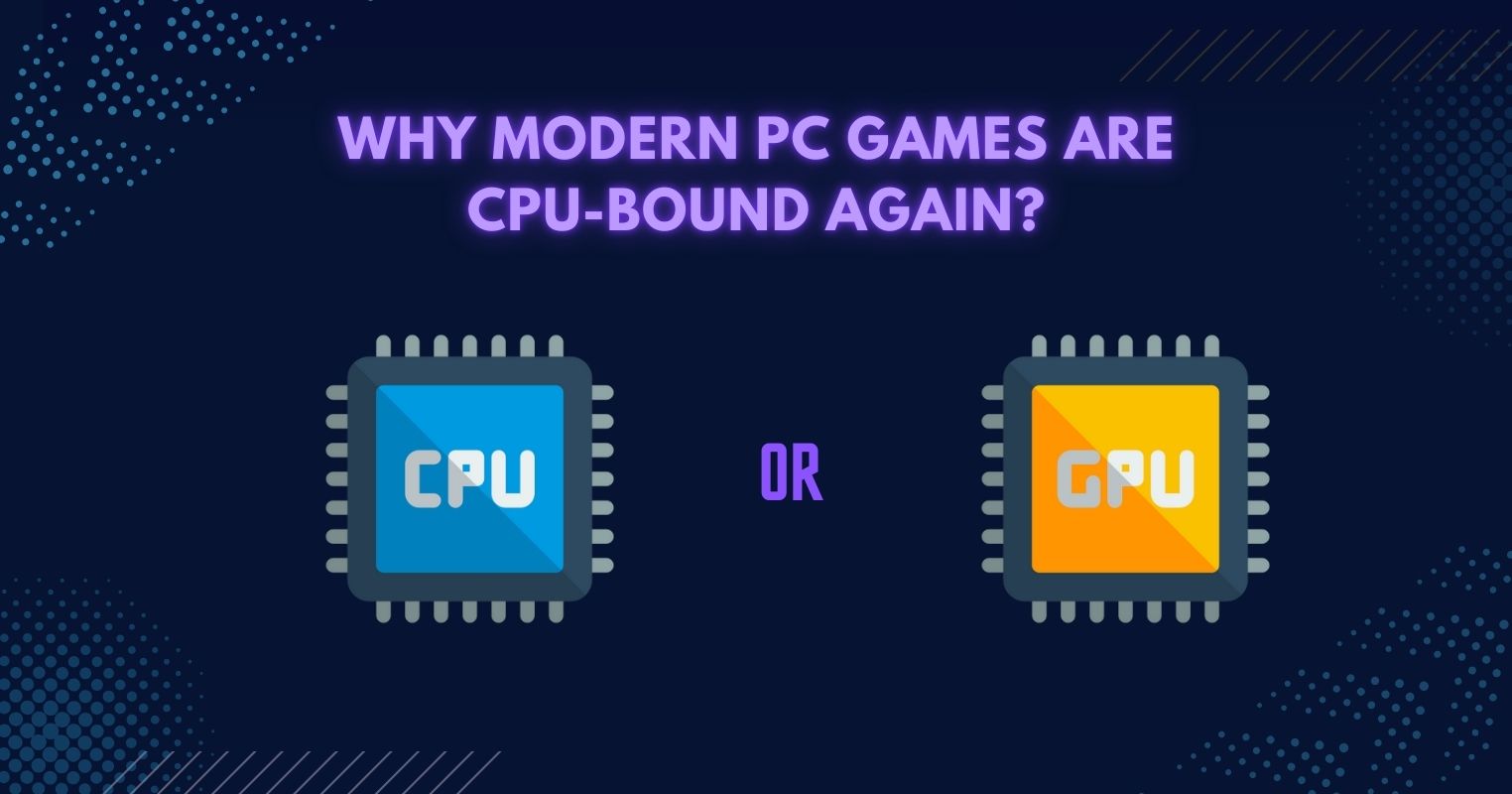- AMD’s record-breaking financial reports and an all-time best desktop CPU revenue share prove that the Ryzen 9000 and Threadripper Pro Series are dominating the higher-end CPU market.
- Intel continues to struggle amidst mass global layoffs paired with Trump’s demand for CEO Lip-Bu Tan to resign, citing national security risks.
- Judging by the extensive historical data of the last two decades, AMD will probably outperform Intel in terms of desktop CPU sales before 2030.
Let’s be real. For decades, the CPU market felt like a one-horse race.
Intel was the undisputed king, and AMD was the plucky underdog that occasionally nipped at its heels.
But oh, how the tables have turned.
As someone who’s been tracking silicon wars since the Athlon days, I’m convinced we’re witnessing a seismic shift, one that will see AMD completely overtake Intel in desktop CPU sales sooner than anyone expects.
And before you call me optimistic, hear me out. I’ve got the numbers to back it up.
The Numbers Don’t Lie: AMD’s Meteoric Rise
Let’s start with the most compelling evidence: cold, hard data.
In Q2 2025, AMD didn’t just have a good quarter; it had its best quarter ever.
To elaborate, AMD reported a record-breaking $7.7 billion of revenue, a gross profit margin of 40%, and a net profit of $872 million, all of which contributed to Team Red’s 32% year-over-year growth.
But aren’t you forgetting something? Yes, that’s right, I’m talking about the U.S. ban on the export of datacenter GPUs like the AMD Instinct MI250 & MI308.
Resultantly, AMD spent an additional $800 million in holding costs due to unsold inventory stockpiles of these AI-based GPUs.
In fact, AMD claims that its gross profit margin would’ve risen to 54% if it hadn’t been for Trump’s export control measures.

But that’s not all.
According to the latest industry reports from Mercury Research, AMD’s desktop x86 unit share surged to 32.2%.
That’s almost one-third of the entire market.
But here’s the real kicker: AMD’s desktop CPU revenue share climbed to 39.3%.
Why does revenue share matter more? Because it means AMD isn’t just selling more chips; it’s selling higher-value chips.
While Intel still relies on volume, AMD is dominating the premium segment.
The Ryzen 9000 series, especially the X3D variants like the Ryzen 7 9800X3D, aren’t just popular; they’re engineering marvels that gamers and creators are willingly paying a premium for.
The hype is real, and it’s translating into dollars.
From Underdog To Top Dog: Closing The Gap
Now, I can already hear the Intel loyalists: “But Intel still has 67.8% market share!” True, but let’s put that in perspective.
Just a few years ago, Intel’s lead was so colossal that AMD’s share was barely a blip on the radar.
Today, the ratio stands at roughly 2:1.

That might still sound lopsided, but in the cutthroat world of semiconductors, this is nothing short of a revolution.
What’s more, AMD shows no signs of slowing down. Quarter after quarter, it’s been chipping away at Intel’s dominance.
Furthermore, with Zen 5 and 3D V-Cache technologies, AMD isn’t just competing—it’s setting the performance standard.
But Intel, on the other hand, seems stuck playing catch-up, struggling with manufacturing delays and outdated lithography.
Even more embarrassing is the nightmare that Intel was subject to last year, where its 13th and 14th 14th-generation processors became the victims of erroneous system crashes caused by faulty microcode that resulted in permanent silicon damage.
Intel’s Mobile Lead: A Silver Lining With Clouds
Okay, let’s be fair. Intel isn’t losing everywhere, not yet.
For starters, the company still leads in the mobile CPU market share, where AMD slipped slightly compared to its 2024 statistics.
Needless to say, laptops remain a stronghold for Intel, thanks to longstanding OEM relationships and efficient integrated graphics.

But let’s not forget: the desktop market is where profit margins are healthiest and where brand reputations are forged.
If AMD continues its desktop dominance, it’s only a matter of time before it replicates that success in mobile.
The Workstation Monopoly: Intel Has No Answer
Here’s where the argument becomes airtight: AMD has effectively established a monopoly in the workstation CPU market.
That’s because Intel has no suitable rival for AMD’s Threadripper Pro 5995WX and 5975WX.
One of Intel’s last attempts at a reasonable, yet capable HEDT CPU was the Intel Core i9-10980XE, which proved itself thoroughly underwhelming, even after drastic price cuts, because of its outdated 14nm lithography.
Anyways, the new Threadripper Pro chips aren’t just powerful; they’re in a league of their own, offering core counts, memory bandwidth, and scalability that Intel simply can’t match.
For content creators, engineers, and data scientists, Threadripper Pro isn’t an option—it’s the only choice.
And as demand for high-performance computing grows, so will AMD’s grip on this lucrative segment.
The Road To 2030: Why AMD Will Probably Take The Lead
Let’s connect the dots:
- Consistent Growth: AMD’s year-on-year track record isn’t just good; it’s stellar. It has consistently gained market share while improving profitability.
- Innovation Edge: With Zen 6 already on the horizon and 3D V-Cache evolving, AMD’s technology roadmap is more compelling than Intel’s.
- Market Sentiment: Enthusiasts, professionals, and now enterprises are embracing AMD. This shift in perception is irreversible.
- Monopolistic Advantage: AMD alone controls the HEDT segment now, which means it can price its Threadripper Pro CPUs as lucratively as it wants.
- Intel’s Struggles: Between manufacturing issues, delayed products, fierce competition, mass layoffs, and political crises, Intel is struggling to reclaim its former glory.
When you combine these factors, it’s clear that AMD isn’t just gaining ground—it’s accelerating.
The era of Intel’s dominance is over. The age of AMD has just begun.
Thank you! Please share your positive feedback. 🔋
How could we improve this post? Please Help us. 😔
[Wiki Editor]
Ali Rashid Khan is an avid gamer, hardware enthusiast, photographer, and devoted litterateur with a period of experience spanning more than 14 years. Sporting a specialization with regards to the latest tech in flagship phones, gaming laptops, and top-of-the-line PCs, Ali is known for consistently presenting the most detailed objective perspective on all types of gaming products, ranging from the Best Motherboards, CPU Coolers, RAM kits, GPUs, and PSUs amongst numerous other peripherals. When he’s not busy writing, you’ll find Ali meddling with mechanical keyboards, indulging in vehicular racing, or professionally competing worldwide with fellow mind-sport athletes in Scrabble at an international level. Currently speaking, Ali has completed his A-Level GCEs with plans to go into either Allopathic Medicine or Business Studies, or who knows, perhaps a full-time dedicated technological journalist.
Get In Touch: alirashid@tech4gamers.com




